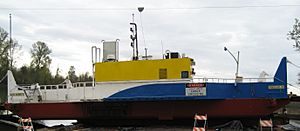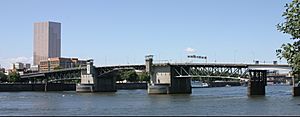Historic ferries in Oregon facts for kids
Historic ferries in Oregon were special boats that helped people cross wide rivers like the Willamette and Columbia. Before big bridges were built, these ferries were the main way to travel, move goods, and share news across the water. Early ferries carried wagons and people walking, while later ones could even transport trains and cars! Today, Oregon still has a few car ferries operating, keeping a piece of history alive.
Contents
Crossing the Willamette River by Ferry
The Willamette River was a very important waterway in Oregon, and many ferries helped people cross it.
First Ferries on the Willamette
One of the very first ferries in Oregon was on the Willamette River near a place called Wheatland. It started operating around 1843-1844. A man named Jesse Applegate ran this early ferry. Later, in the 1850s, Daniel Matheny started the famous Wheatland Ferry in the same area, which still runs today!
Another early ferry was the Michel Laframboise Ferry. It crossed the Willamette River between Champoeg and the north bank from 1850 to 1857.
The well-known Boones Ferry began in 1847. It was operated by Alphonso Boone, who was the grandson of the famous explorer Daniel Boone. This ferry near Wilsonville operated for a very long time, until 1954, when a modern bridge was finally built.
Ferries in Benton County
Around 1860, a ferry started crossing the Willamette River at Corvallis. This helped people and goods move in and out of the growing town.
Ferries in Polk and Marion Counties
Many ferries used to operate in Polk and Marion counties. The Claggett ferry at Independence ran until 1950. Hales Ferry, near Jefferson, was one of the earliest, operating as far back as 1846!
Doaks Ferry operated north of Salem. It was started in the 1840s by Andrew Jackson Doak. The road nearby, Doaks Ferry Road, is named after it. Another ferry, Spongs Ferry, operated across the river at a place now called Spong's Landing Park.
Halls Ferry started in 1868, south of Salem. It was first run by Isaac Leabo, then sold to Benjamin Franklin Hall in the 1880s, which is when it got its name. Hall's father, Reason B. Hall, started the Buena Vista Ferry in 1852, which is still running today! Halls Ferry changed owners and names a few times before it stopped operating.
Salem's Busy Ferry
The ferry in Salem was started by James White in 1846. He later partnered with William H. Willson, who helped found Salem. After White passed away, his wife ran the ferry for a while. She later partnered with Jasper N. Matheny, whose family also ran the Wheatland ferry. The ferry company changed hands many times over the years. It finally stopped operating in 1905.
Ferries in Clackamas County
In Clackamas County, Robert Moore operated a ferry between Linn City and Oregon City starting in 1849. Hugh Burns also ran a ferry around the same time in Oregon City.
Ferries in Lane County
A ferry run by A. & L. Coryell operated near where the Middle and Coast forks of the Willamette River meet, as early as 1847.
Willamette Ferries Still Running Today
Even today, you can still ride a few historic ferries on the Willamette River! The only ones still in operation are the Wheatland Ferry, the Buena Vista Ferry, and the Canby Ferry. They are a fun way to experience a bit of Oregon's past.
Portland's Ferries
The Portland area also had many important ferries. One of the first was Switzler's ferry, which crossed the Columbia River in 1846. It connected Fort Vancouver (a trading post) with the south bank of the river.
In 1848, Stephen Coffin started a ferry on the Willamette River using a wooden platform on canoes. The Stark Street Ferry operated from 1855 until 1887, when the Morrison Bridge opened. When the bridge stopped charging tolls in 1895, even fewer people used the ferry.
In 1888, a railroad bridge (the original Steel Bridge) was completed. This meant the Oregon & California Railroad no longer needed their passenger ferry, which had used barges to move trains across the river since 1870.
The Spokane Street Ferry, also called the Sellwood Ferry, carried passengers across the Willamette between Sellwood and west Portland. The last ferry on this route, the John F. Caples, stopped running in 1925 when the Sellwood Bridge opened.
The very last ferry service in the Portland area was the Sauvie Island Ferry. It was replaced in 1950 by the first Sauvie Island Bridge.
Columbia River Ferries
Ferries also played a big role in crossing the mighty Columbia River.
One famous ferry was the steel Kalama (later called Tacoma). This huge boat transported entire trains between Kalama, Washington, and Goble, Oregon! This train ferry was so big it was shipped in over 50,000 pieces around Cape Horn and put together in Portland. It was 338 feet (103 meters) long and 42 feet (13 meters) wide. The Kalama operated from 1883 until around 1910, when a railroad bridge was finally built across the river.
The Astoria–Megler Ferry operated at the mouth of the Columbia River, connecting Megler, Washington, and Astoria, Oregon. This ferry ran until the amazing Astoria-Megler Bridge was built in the 1960s. There was also a ferry between Biggs, Oregon, and Maryhill, Washington.
Other Important Ferries in Oregon
Oregon had many other ferries in different parts of the state.
Coastal Ferries
Along the Oregon Coast, many ferries helped people cross bays and rivers until the 1930s. That's when new bridges were built for U.S. Route 101, making travel much faster. One ferry, Bullards Ferry across the Coquille River, lasted until the mid-1950s when the Bullards Bridge replaced it.
Southern Oregon and Eastern Oregon Ferries
Other ferries operated in Southern Oregon to help people travel towards California. In Eastern Oregon, Brownlee's Ferry started crossing the Snake River between Oregon and Idaho in 1862. Olds Ferry was founded a year later, further upstream.
Tualatin River Ferries
Ferries also operated across the Tualatin River. One was Scholls Ferry at Scholls, run by Peter Scholl starting in 1850. This was an important route between Portland and the Willamette Valley. Scholl even built a covered toll bridge, but a flood washed it away. A more permanent bridge came in 1870. Philip Harris also operated a ferry across the Tualatin at Farmington.
Rogue River Ferry
In Southern Oregon, a woman known as "Indian Mary" operated a ferry across the Rogue River in the late 1800s.
Images for kids






